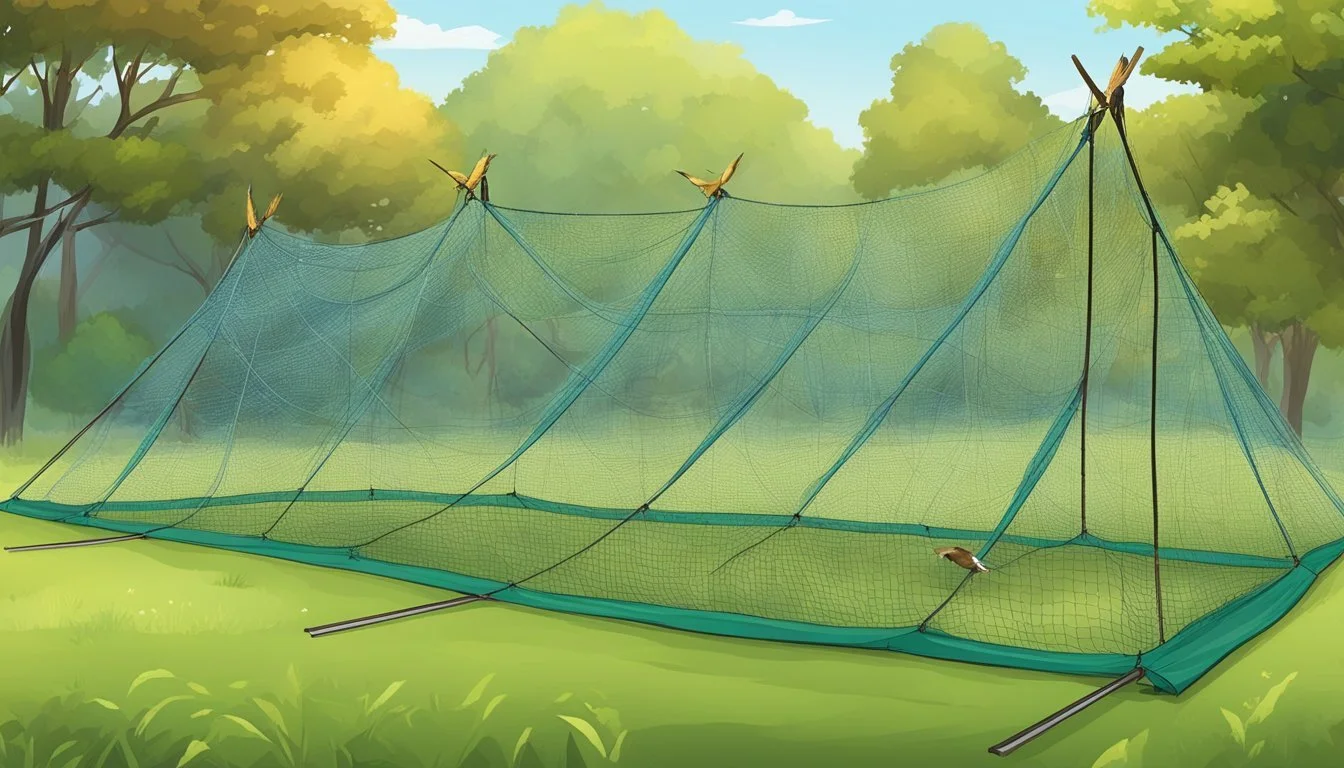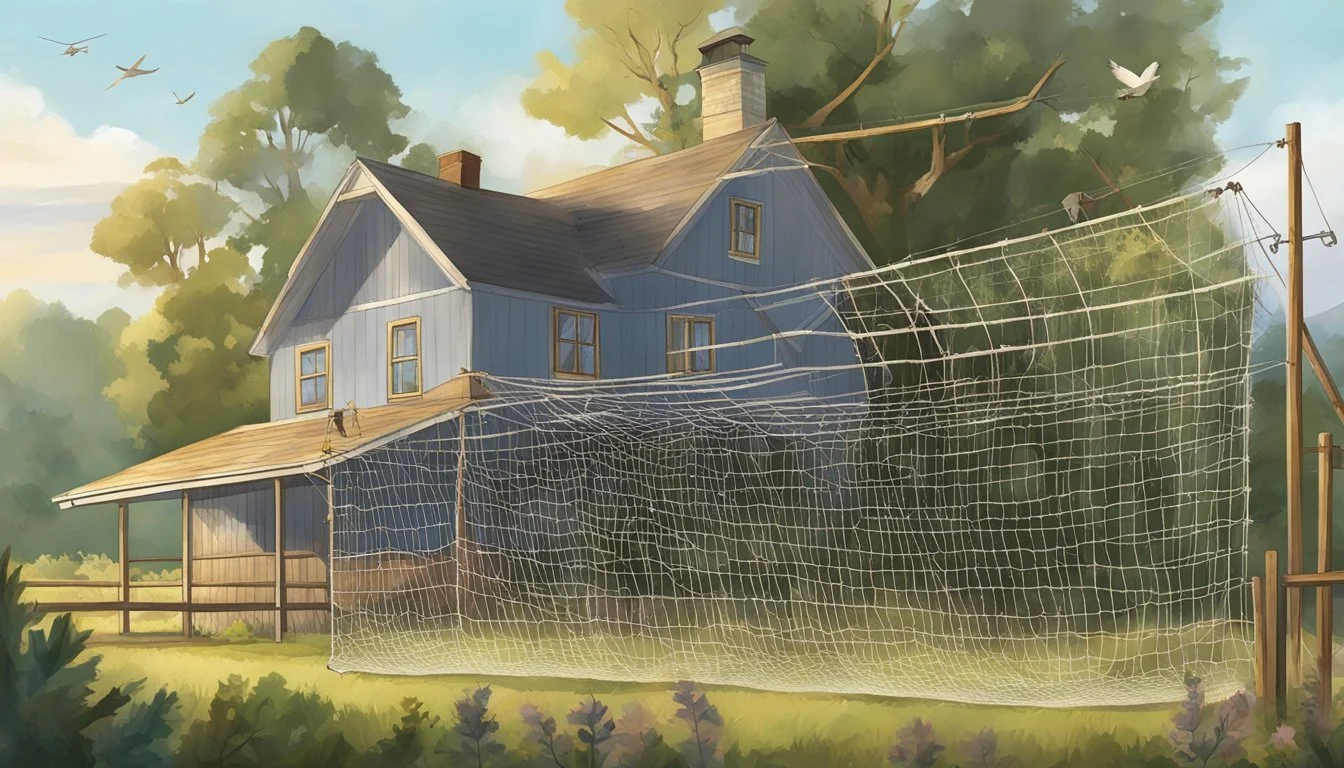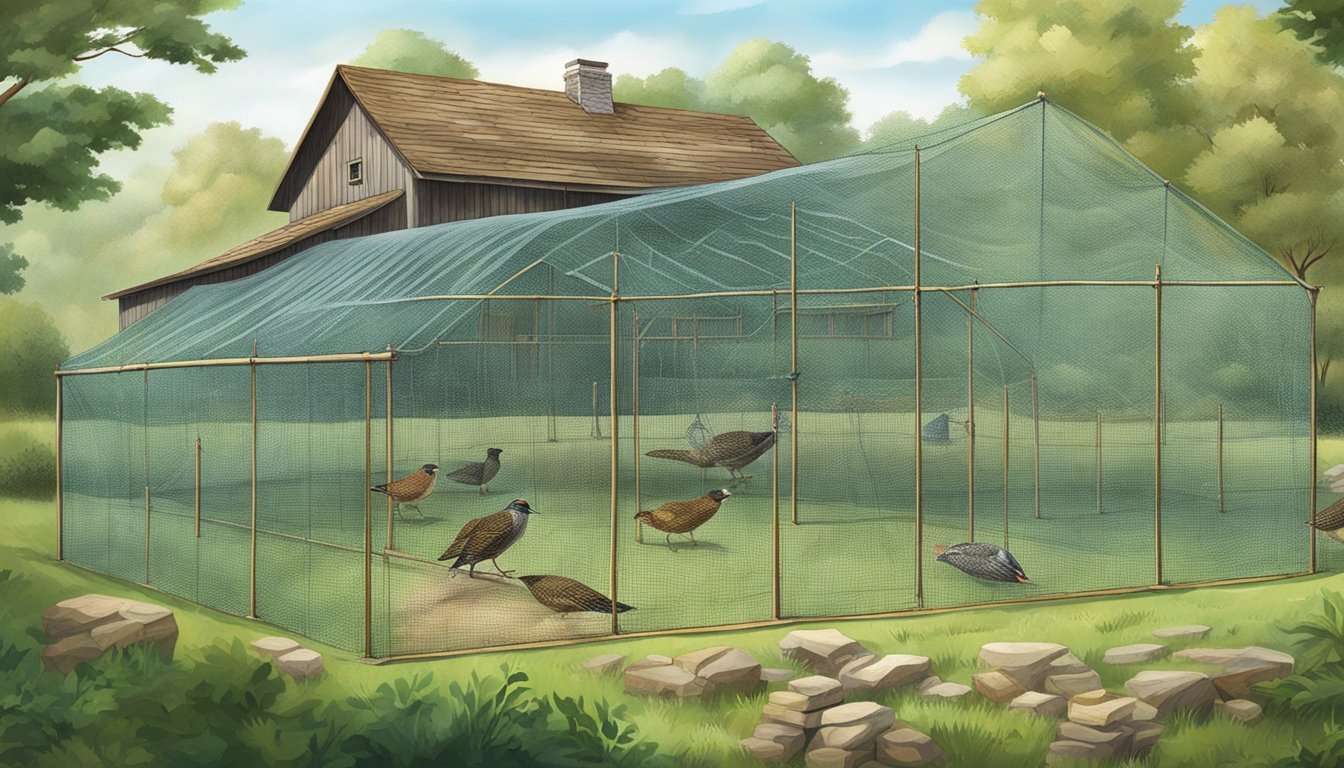The Ultimate Guide to Game Bird Netting
Secure Your Homestead's Aviary Effectively
Game bird netting is an essential component for those who rear game birds on their homesteads. It provides a reliable method for preventing birds such as pheasants, quails, and partridges from escaping their designated enclosures, ensuring that the birds remain safe and contained. Effective netting not only keeps the birds within a controlled environment but also protects them from external predators and mitigates risks related to their wandering off, which could impact their well-being and owners' investment.
When selecting the appropriate bird netting, one must consider the particular needs of both the birds and the homestead. The netting material should be durable enough to withstand the elements and the potential abrasion from birds' beaks and wings. Furthermore, the mesh size of the netting is a critical factor, as it must be small enough to prevent birds from slipping through without obstructing their view and allowing for proper ventilation.
Strategically installing and maintaining the netting is just as important as the material selection itself. It should cover the entire enclosure to create an impenetrable barrier but without harming the birds. Ensuring a taut and secure fit will reduce the risk of birds finding gaps or weak points they could exploit. Homesteaders must regularly inspect the netting for signs of wear or damage that could compromise its integrity, addressing any issues promptly to maintain a secure and effective barrier.
Understanding Game Bird Netting
In managing a homestead with game birds, the selection and use of appropriate bird netting are crucial. This section offers insights into the varieties of netting materials, mesh sizes, and their particular features that can help in crafting a secure environment for game birds while deterring predators and pests.
Importance and Benefits
Game bird netting is a fundamental aspect of keeping flight birds safely contained within their pens, ensuring they do not escape and that they are protected from predators such as hawks and other pests. This netting also provides a barrier that is both UV resistant and rot resistant, fostering a durable enclosure for game birds.
Types of Bird Netting Materials
The most common materials used for bird netting are polyethylene, nylon, and polypropylene. Each material has its own benefits:
Polyethylene: This material is lightweight, UV resistant, and offers good flexibility.
Nylon: Known for its exceptional strength and durability, nylon netting is also rot and rust resistant.
Polypropylene: Less expensive than nylon, it's resistant to water and UV damage but is not as strong as nylon.
Comparing Mesh Sizes and Strength
Mesh size is a critical factor when selecting netting. It is measured by the size of each square hole in the netting. Smaller mesh sizes prevent smaller birds from escaping and also deter smaller pests:
Mesh Size: Small, Ideal for: Keeping out small birds and pests
Mesh Size: Medium, Ideal for: General purpose bird protection
Mesh Size: Large, Ideal for: Larger birds such as pheasants
Alongside mesh size, the strength of the netting must be considered for heavy-duty applications, especially when housing birds with stronger beaks or in areas with heavy predator activity.
Specialized Netting Features
Specialized netting may include features such as being knotted or knitted.
Knotted Netting: Offers additional strength, making it more durable and heavy duty.
Knitted Netting: Typically more lightweight and may include built-in UV resistance.
Assessing Your Needs
Homesteaders should assess the specific needs of their game birds, considering factors like the birds' size, the presence of predators, and environmental conditions. Assessing these factors will determine whether standard or heavy-duty netting is required.
Netting Dimensions and Sizing
When planning the construction of a pen or flight pen, accurate dimensions and sizing of the netting are vital. The width and length of the net should cover the entire area without leaving any gaps. Aviary netting is usually sold in various widths and lengths, completely customizable to fit the dimensions of your pens.
Dimensions: Width, Usage: Match to pen's width, allowing some extra for securing
Dimensions: Length, Usage: Match to pen's length, similarly allowing for excess
Dimensions: Mesh Sizes, Usage: Choose based on the size of the birds and potential pests
Providing the right size and type of netting can help ensure the longevity of the solution and reduce maintenance needs.
Preparation and Installation
To effectively prevent game birds from escaping on a homestead, preparation, and installation of the right netting materials and processes are crucial.
Selecting the Right Equipment
Choose aviary netting of the appropriate size to serve as a physical barrier, ensuring it is tangle-free to prevent harm to the birds. The netting material should be durable, weather-resistant, and offer adequate protection. Size selection is vital; the mesh should be small enough to contain the species of bird but large enough to discourage tangling and injury. Alongside netting, gather all necessary hardware for installation, such as ties, clips, poles, stakes, nails, and zip ties.
Installation Process Guide
Measurement and Cutting: Accurately measure the area to cover, and trim the netting to size while allowing for some overlap at edges for a secure fit.
Creating a Frame: Use poles or stakes at regular intervals around the perimeter of the desired area, ensuring they are level and firmly anchored.
Attaching Netting: Start at one end and attach the netting to the frame using hog rings or zip ties every few inches to maintain tension and prevent gaps.
Tips for Secure Netting
Tension: Keep the netting taught to prevent sagging and potential escape routes for birds.
Overlapping: Ensure that the ends of the netting overlap and secure them with clips to prevent birds from squeezing between gaps.
Regular Checks: Inspect the installation periodically for wear and tear. Replace or repair any damaged sections promptly to maintain security.
Maintaining Safety Measures
When installing, always prioritize safety for both the installer and the birds. Use appropriate personal protective equipment.
During and after installation, ensure there are no protruding parts or sharp edges that could injure the birds or people.
In conclusion, the preparation and installation of game bird netting require attention to detail, proper equipment, and ongoing vigilance to maintain an effective barrier.
Protecting Against Weather and Wildlife
Incorporating effective strategies for weatherproofing and deterring wildlife is critical to the sustainability of game bird netting systems. These measures safeguard against environmental degradation and persistent pests or predators.
Weatherproofing Game Bird Netting
Materials and Coatings:
Use UV-resistant materials such as polyethylene or nylon.
Apply coatings for added UV protection to prevent netting from becoming brittle.
Installation Techniques:
Secure netting with heavy-duty clips or zip ties.
Implement a taut setup to withstand weather extremes without sagging.
Deterring Birds and Pests
Bird Control:
Overlap netting sections securely to prevent entry points for birds and pests.
Install bird spikes on top of netting supports to discourage roosting.
Rodent and Predator Deterrence:
Bury the bottom edge of the netting or use a rodent-proof skirt to thwart burrowing.
Regularly check for signs of gnawing or tampering by rodents or other predators.
Enhancing Durability Over Time
Routine Maintenance:
Conduct maintenance checks after severe weather conditions.
Replace any damaged clips or sections of netting promptly to ensure continuous protection.
Sustainable Practices:
Opt for durable, weather-resistant materials that offer longevity.
Invest in netting that requires minimal maintenance and care to prolong its usability.
By integrating these targeted measures, the integrity and effectiveness of game bird netting for preventing flight birds from escaping can be robustly maintained.
Maximizing Harvest while Hosting Wildlife
An optimal balance between wildlife conservation and agricultural productivity is crucial. Employing strategic measures can prevent bird damage to crops while maintaining a welcoming environment for pollinators, thereby promoting a bountiful harvest.
Balancing Bird Protection and Pollination
Implementing netting solutions needs to be done judiciously to protect crops from bird damage without impeding the activity of pollinators. Bird netting, when correctly installed, acts as a shield that keeps birds away from the crops, yet allows bees and other pollinators to pass through and do their vital work. It's essential to use netting with mesh sizes that deter birds but permit pollinators to reach the flowers.
Preventing Bird Damage to Crops
The use of anti-bird netting can greatly reduce crop loss due to birds. For effective protection:
Ensure complete coverage of the area, leaving no gaps for birds to enter.
Install netting before crops begin to fruit to avoid attracting birds.
Choose durable materials that withstand weather and UV degradation.
Regular inspection and maintenance of netting are vital to ensure that it remains an effective deterrent throughout the growing season.
Promoting a Bountiful Harvest
To achieve a bountiful harvest while coexisting with avian wildlife:
Monitor bird activity: Understand local bird populations and adjust netting installation accordingly.
Timing: Apply netting at critical growth stages of the crops to prevent bird damage.
Employ companion planting to attract beneficial insects that contribute to a healthy garden ecosystem.
By integrating these methods, one can enjoy the dual benefits of a rich harvest and the presence of beneficial wildlife on their homestead.
Routine Maintenance and Care
Maintaining game bird netting involves regular inspection and prompt repairs to ensure it remains durable and effective. A proper care regimen extends the lifespan of the netting, safeguarding against the loss of birds.
Periodic Inspection Tips
Regular inspections are critical for identifying potential breaches or weaknesses in the netting. Owners should:
Check for tears or holes: Even the smallest gap can be an escape route.
Inspect fastenings: Zip ties or twine should be secure and without wear.
Evaluate for UV damage: Prolonged exposure can weaken the netting, making it less effective.
Cleaning and Repair Techniques
Cleanliness and timely repairs prevent damage from escalating. To maintain netting:
Remove debris: Gently brush off leaves and detritus.
Use mild, bird-safe detergents: Keep the netting free from mildew and dirt.
Patch holes: Durable materials like original netting or similar flexible fabric should be used for repairs.
Longevity Strategies for Netting
To enhance durability and longevity of bird netting:
Employ UV-resistant materials: These resist sun damage and extend the life of the netting.
Rotate netting: Periodically change the position to distribute wear evenly.
Store properly when not in use: Keep it dry and free from pests, rolled up to avoid creases.
Replacement and Upkeep Schedules
A structured schedule ensures netting is at peak performance. It is recommended to:
Conduct minor check-ups monthly.
Perform thorough inspections semi-annually.
Replace the netting every few years or as soon as significant wear is noted, even if repairs have been done.
Legal and Ethical Considerations
When securing game birds on a homestead, one must navigate the intricacies of wildlife preservation laws and adhere to responsible netting practices. These regulations ensure sustainable management of wildlife populations and uphold ethical standards of animal welfare.
Wildlife Preservation Laws
In the United States, the Migratory Bird Treaty Act protects many bird species, including game birds. This legislation makes it illegal to harm or disturb birds, their nests, or their eggs without proper authorization. Homesteaders must ensure that any netting used complies with these laws, taking care not to cause unintentional harm to protected birds. To complicate matters further, individual states may also have additional regulations that need to be adhered to.
Key acts to consider:
Migratory Bird Treaty Act
Endangered Species Act (if applicable)
Responsible Netting Practices
Using game bird netting responsibly is not solely a legal obligation, but also an ethical one. Netting must be installed in such a way that prevents injury to the birds and minimizes stress. Homesteaders are expected to regularly inspect and maintain their netting to ensure its integrity and the safety of the game birds. Sustainable netting solutions involve materials that are durable, UV treated for longevity, and designed to prevent escape without causing harm to the birds.
Best practices include:
Regular inspection for wear or damage
Use of UV treated materials for durability
Proper installation to prevent gaps and sagging
Sustainable and ethical netting is pivotal to maintain the balance between keeping game birds secure on a homestead and observing wildlife laws.
Conclusion
When securing game birds on a homestead, it is imperative to select and install high-quality netting. This ensures both reliability and provides owners with peace of mind. Properly installed bird netting serves as a humane barrier, preventing escapes while protecting the flock from potential predators. The chosen netting should feature durability against weather and resist the wear from birds' beaks and movements.
One should employ regular maintenance checks to ensure there are no breaches. Even the smallest gap may lead to escape or intrusion. Professional installation techniques must be observed, such as keeping the net taut and inspecting for any damages routinely.
In summary, the application of dependable bird netting translates to a well-maintained environment for game birds. It allows them to thrive within the safety of the homestead, negating potential risks from outside and preventing loss. Through this guide, homestead owners should feel confident in their ability to choose and implement effective bird netting solutions.







